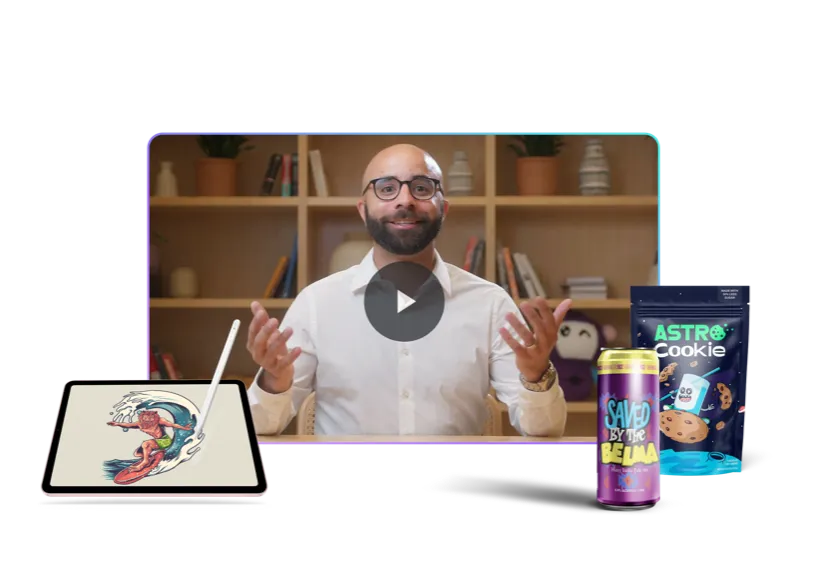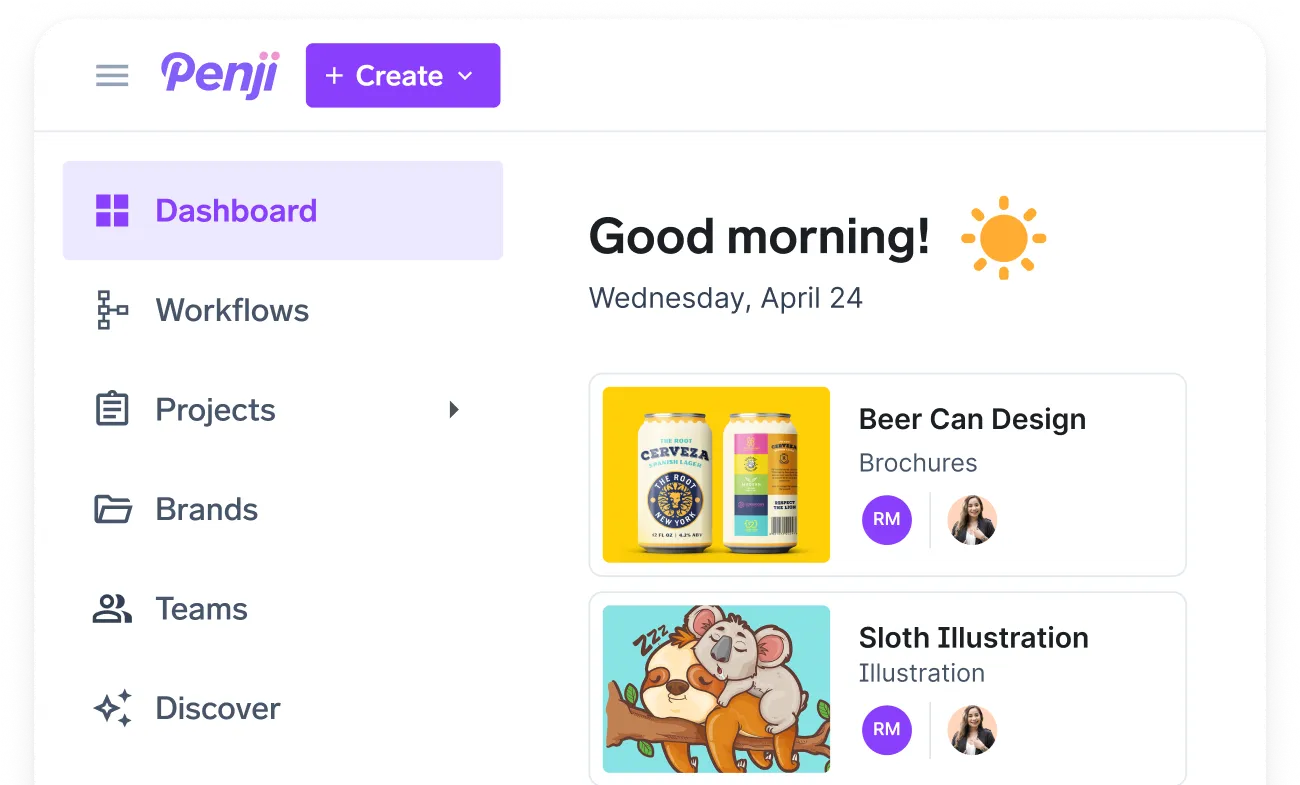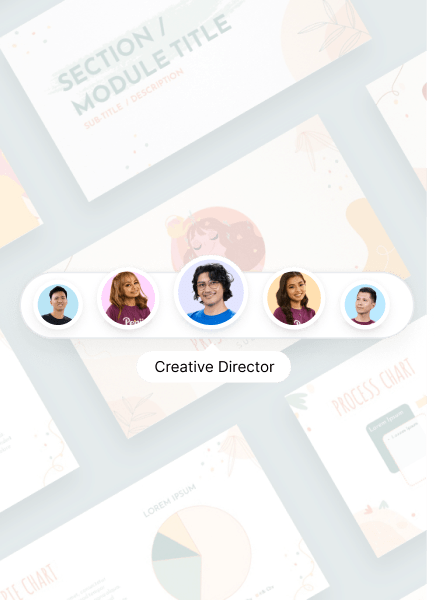![[Fully Managed] Zac Fromson from Lilo Social Ep. 190](https://penji.co/wp-content/uploads/2025/08/BLOG-IMAGE-Zac-Fromson.jpg)
Shannon: Hello, everyone, and welcome to the Fully Managed Podcast. I’m your host, Shannon, and I’m here with Zac. Thank you so much for joining me today. I really appreciate it.
Zac: Yeah, super excited to be here. Thanks for having me.
Shannon: Heck yeah.
Game: Advertisement or Imagination
Shannon: So we are going to start this with a little game. This is a new one. So I hope you like it. If you don’t, you’ll be my test dummy. So it’ll be great. So this is called advertisement or imagination. So I have a bunch of, what would I call it? I guess slogans for advertisements. Some of them are fake that I made up and some of them are real that are actual campaigns. And I hope I can trick you. That would be the best part about this. If I can at all, that would be kind of embarrassing. But so are you excited?
Zac: Let’s see what I can do.
Shannon: All righty. Perfect. Okay. First one. Don’t buy our moisturizer. Seriously. It’s too good for you. Real or fake?
Zac: I would say. How about fake?
Shannon: It is fake. It is fake. Darn. Okay. Okay. Shoes made from sugar. Literally.
Zac: Okay. I’ll say it’s real.
Shannon: It is real. Darn. Okay. You’re so good at this. Okay. Okay. Our candles are like therapy but cheaper.
Zac: That’s real.
Shannon: It is real. Oh my god. Wow. I’m not stumping you at all. Okay. Okay. That means it’s a bad game. That just means you’re so good. You’re so good at ads. Okay. We stole this recipe from your grandma.
Zac: That one’s real.
Shannon: It is fake. Did you say that because you felt bad for me?
Zac: Maybe.
Shannon: You can’t win them all, right? Okay, okay. Upgrade your boxers. Your downstairs deserves a doorman.
Zac: That’s real.
Shannon: That is real. That is me undies. Okay. Okay. You don’t need this product, but your ex’s new partner probably has it.
Zac: I’d say that’s real.
Shannon: It is fake. Honestly, that’s really funny though and someone should steal it. That’d be a crazy one. Okay. Your inbox deserves better spam.
Zac: That’s fake.
Shannon: Yeah, that’s fake. Okay. Do I have… No, that’s it. That’s it. You did great. You only got, what, two wrong? Yeah, two wrong. Yeah. Five, six, seven. Yeah, great. That was amazing, honestly.
Zac: Well, thank you for participating in my game and entertaining me. I thought that was fun.
Zac’s Background and Journey
Shannon: But so getting into it, I’d love for you to tell me more about yourself. Tell the audience about you. What are you doing today? What led you on the journey that you got to here today? And anything that you think is relevant to explain, I’d love to hear.
Zac: Cool, yeah. So I’m a co-founder of Lilo Social. We’re a full-funnel e-comm agency. Been at it since about 2018. Started that journey as just a paid social agency pretty early on. Since then, we’ve kind of evolved into becoming a lot more advanced in creative, paid search, UGC, email, SMS is also probably just under about half of the business. So going pretty rapidly, we’re a team of about fifty and we’re fully remote. So kind of working here across quite a bit.
Initially we got started, really just kind of just really honed in on paid social. The landscape was much different back then. Creative was important, but not as much of an emphasis pre iOS changes. So our business has adapted and changed, grown, kind of solved problems where we were having issues throughout the funnel, whether it be on site or post-purchase. And that’s kind of where we built out the other departments just to make sure we don’t really have fall off as we’re working with someone that If there’s a problem somewhere throughout the funnel, we can hop in to help them address it.
So it’s been a fun growth path. A lot of changes went from an office in Dublin, Brooklyn to a fully remote team through COVID. So a lot of adaptations, a lot of changes through our trajectory, but it’s been a fun journey to get here.
Remote Work Transition
Shannon: Did you stay – so you stayed fully remote after COVID?
Zac: Yeah. Yeah, it wasn’t the plan, but as everything happens and changes, being in the obviously the e-com space, there was just such an e-com boom. Unfortunately, being in New York, it was kind of the epicenter of COVID. So we need to grow, we need to hire talent. It was really difficult to hire talent in New York when everyone had exited. So we were hiring talent outside of New York and we had grown so substantially by the time it was feasible to consider a return to office that it was just unfeasible for us to ask everyone in South Carolina, Florida, Texas to pack their stuff up and move back to Dumbo. So Brooklyn was all shut down from an office perspective, kind of why we adapted.
Shannon: Yeah, that makes complete sense. What were some of the struggles that you dealt with that? Because I’m always curious, there’s, I know, the routine ones in which a lot of people struggle with, especially, I think so many people move to remote during COVID, because it was just and then never went back. But what do you think some of the biggest problems that you have, like being fully remote now even?
Remote Work Advantages and Culture
Zac: I honestly I think it’s more of an advantage than problems honestly I kind of think the the format works really well for us it might not for for every company but I think it does take a certain type of person to work for us and work in this environment to be here right now everyone is a great fit for for fully remote so I think for us like you know everyone comes in that has some pretty solid level of experience I think like probably the struggles is some of that like training of like more junior talent probably just isn’t as feasible as accessible as it was without some of the hands-on training and learning but we really supplemented culture in some really great ways
I think we kind of knew we had to keep things fun and adapt even during covid just try to keep spirits up and we were just working really hard so it was just a matter of also just trying to grow the team so we do a lot of digital events a lot of culture things are built out here we have a book club we have a fitness club so a lot of things where people like track and can meet and talk about books or track fitness goals, places to share their pets. We do game days every other Friday and just things that people can join in. It’s almost like clubs, if you would, within the company.
We’ve gotten to a big enough size where it’s easier to do that, where people can kind of break out in subsets where maybe there’s eight people in the book club and seven people in the fitness club rather than just being a company of seven or eight, which I think is a little more challenging to get now.
Shannon: Yeah, that would be kind of funny if you didn’t have anyone in your club.
Zac: Yeah, so it’s a little different as we’ve grown to kind of have the accessibility to do things like that. And people can kind of gravitate to what they’re interested in. Nothing’s mandatory. Some people like to keep to themselves, just want to work, love that they don’t have to commute. They can come in and just work hard and be a part of it. Some people really want to get to know their colleagues a little bit deeper and can really get themselves more immersed in some of the team building activities that we’ve kind of set in place, which kind of just adapts for the, you know, beers after work kind of situation or, you know, the softball teams and things like that, that kind of existed when we were in office. And we’ve kind of been able to adapt that to just different things culturally, which suits some people who want it really, really well. And those who don’t, you know, just might not be a fit if you really need to be in person or you can’t focus from home. So I think there’s just definitely some boundaries that are set in place and some people fit really really well within them.
Shannon: Yeah that’s really nice I think that it’s nice to also have the choice because some people don’t like to do those work things I think and sometimes they feel forced to if it’s like the whole company is doing those things whether they like who they work with or not some people just aren’t that kind of social person so it’s it’s kind of nice remotely to be able to like participate and have that community if you want but you don’t have to.
Zac: Yeah exactly we used to have like these game nights like once a quarter and like we made them mandatory and we’ve kind of stopped doing that where everything is just like you opt in and you participate if you want to we just make announcements and have opportunities for people to hop in and join things and they just happen where they want to or stay out where they don’t so no one feels pressured or uncomfortable and people who are there truly want to be there so it’s actually meaningful for those who do want to participate.
Shannon: Yeah it must be obviously turnout is kind of nice it would really suck if you made it optional and like a couple people showed but it’s also you know that’s I feel like even when it becomes like one of those smaller things or maybe you’re like a little upset about turnout you get to know those people more and I think that’s really valuable regardless of like the amount of people from the company that show up.
Zac: Yeah small groups are still meaningful if anything they’re better especially digitally it’s just really hard to hop in on a conversation sometimes it can be overpowering so I think small groups are still really meaningful.
Remote Work Social Connections
Shannon: Yeah, no, I agree. I think that’s really lovely. And I think that having those avenues to be able to create those connections even remotely is something that’s really important. I think I always ask people about that that are fully remote because I’m so curious of the different ways in which people foster that kind of community, because I do think that sometimes we lose that sense of like closeness when we’re fully remote. Sometimes people get really sad about it, whether they’re, you know, maybe they work really well remotely, but they do kind of miss like having friendships with coworkers and like being able to, cause a lot of people meet their friends at work and that’s kind of how it works. It’s hard to meet friends at work sometimes when you’re remote. But so I’m always curious.
Zac: Yeah, I hear you on that. I think, you know, you, you do lose that where like most people are in the same town or the same city, you know, people do do meetups and people travel that they’ll get together. Like we will do some like offsite things like that at times, but it’s a different experience that you definitely need to cultivate your own social life and your own social experience outside of work. You can have some connection and conversation and some people will call and text and like, I become close with, with colleagues, but you might just not be able to like grab dinner and coffee on a Friday night. So you’re just going to have to kind of stimulate that yourself. So I think if you’re striving for that socially, you just won’t achieve that here. And I think just something to evaluate as you’re thinking about like what’s important to you in a role in a company.
Shannon: Yeah, you can always like work towards something too. I guess I have a co-worker here. That’s my co-host, Daniela. She lives in El Salvador. And I have never even left the country. But we constantly talk about meeting up one day because we just think that would be really nice. And like we’ve become very close like since working here together. And I think that that’s it is a possibility even if you’re far away and maybe it’s a pipe dream sometimes, but it’s also something to look forward to, which is really nice as well. And it’s always possible. It’s just, you know, it’s just more difficult than going out with someone that, you know, lives in your city.
Zac: Yeah. You just have to put more effort to plan it and make it happen. We’ve done it too. We’ve had people who’ve been outside the country who we’ve flown in or things like that coming from Canada or doing meetups. So it’s really just a matter of just locking down a date and just making it happen, you know?
Shannon: Yeah, exactly. Do you ever have like group events that you fly everyone in or anything like that?
Zac: We’ve never done a full team session, which is probably just too spread out. It would be a heck of a coordination to make that happen. And we haven’t undertaken that, but as like me and my co-founder travel and we’re in people’s cities, we’ll definitely go out of our way to make sure we meet up. So we’ll travel to meet some people. And then like management, we’ll get together, which is a little bit different just for like offsite management plannings and some team building there. But yeah, never done like an all hands off session I guess like session where like we brought in everybody it’d be I think quite the difficult endeavor given just how spread out everyone is just of course.
Shannon: Okay we have a similar situation I definitely have not met most of the people that in person at least most of the people that work at the company but it You know, maybe one day, maybe one day.
Zac: I love it, but I need a full time coordinator to make it happen.
Shannon: Yeah, it’s a very difficult feat to organize. So I completely understand.
Changes in Social Media Marketing
Shannon: Well, switching topics a little bit. So having been in the world of social media for so long, I love I love hearing people’s opinions on this. So What do you think the biggest thing has changed since Lilo Social became about social media that you’ve had to navigate around?
Zac: I think if I look at paid specifically, which is kind of where we play, we don’t do as much organically. I think paid is really kind of where we spend most of our time. I think some of the biggest stuff that has changed for us is tracking attribution and emphasis on creative. I think the biggest overarching thing is that I think those things have made it more difficult to be competitive in the space but I think that’s kind of the biggest thing is competition
I think just like the amount of people who are spending on meta in general or just even across social platforms has just increased I think e-commerce has just become much larger and much more prevalent and I think just become extremely competitive within this space where there’s so many people that are hopping in and getting involved so think it used to be a lot easier to find success and build momentum where now it’s probably you need to have better processes leaner teams you have to double the output you just need to be successful so I think it’s just more competitive you have to be more savvy you kind of have to find ways to increase output without necessarily driving increased costs you can’t necessarily just double your teams necessary you kind of feel a little more creative on how to produce what you need and get the volume you need to be successful on social and kind of beat out some of the competition. There’s just so many options to pick from and you’re just bombarded with that now that it’s really just the platforms have become saturated where it’s just you got to grab and if you don’t get them, you’re probably on to the next.
Creative Volume Strategy
Shannon: Yeah, well, then do you recommend volume as like the best strategy for kind of like standing out from all the noise or like the competition? Or do you have like something that you think is your key way of standing out amongst the competition?
Zac: Yeah, I think for us, definitely creative volume is becoming the massive impact. I think with Meta’s most recent updates here, like they’re kind of going to move away from business as usual, ABOs, CBOs, they’re really pushing, you know, advantage plus campaigns here just to get into shopping. So really just trying to feed that high volume creative is really kind of where we’re headed. And I think we’re trying to drive our clients here to get, you know, ideally mass amounts of creative.
You know, I think if you have different cost objectives across multiple SKUs or you have different AOVs, different price points, maybe you have to have a couple of campaigns to suit that. Assuming you’re a single AOV type store and all your products are like and kind from a price point. It’s really just getting a volume game and letting Facebook’s machine do its job. So I think for us, it’s a little bit less about interest audiences and even a little bit less about your account structure, complexity of anything, simplified structure with high creative volume and just a really high T of how you manage the account when you hit some shutoff valves on certain creatives is more important. But for us, creative output hypothesis testing is really what drives the account at this point.
Shannon: Do you have any scenarios where you kind of did something more experimental to see if that output would be better and it was successful?
Zac: Yeah. I mean, we’ve been upping the output, you know, over the probably past six to twelve months for a lot of our clients, just getting more into the account. There’s always a balance of like brand look and feel, but I think we’ve kind of pushed them. Our clients say, Hey, we went to love every creative, but let’s, let’s just test more. Let’s get more volume in. Let’s let it prove it out. I think, you know, there’s times where like the creative that no one really wanted to run ends up doing extremely well, for whatever reason, right. In some instances, but we would have never known that we weren’t comfortable testing volume.
And I think that’s, you know, also a larger message for some brands that might be struggling or not doing exactly what they want to do. Like you have to be a little less focused on every last pixel in detail to get through that volume to get that out the door sometimes getting caught up on some small little things might slow down the testing and the learning so I think speed is also a huge factor that a day lost is a day never returned for kind of a revenue goal for the year so we just gotta get volume out creative doesn’t matter quality doesn’t matter don’t get me wrong and brand is super super important but I think there just needs to be a way to have templates, make variations, try different headlines, just try to get as most out of a creative as you can and try to test that and recut that as many ways and try to get as much volume into the account.
I think accounts that don’t have you know, hundreds of creative that we can work with are certainly gonna see a lot more ability to be successful than brands that have ten, twenty, thirty creative. It’s just a lot less volume in the account. It just gives Meta so many more options to pick from to kind of diversify spend across multiple creative rather than being siloed in just a couple.
Quality vs. Quantity Balance
Shannon: It’s so interesting to hear like the volume approach where like you might be sacrificing quality for quantity because I do, I guess I hear different takes about that. So do you, is this a new strategy that you adjusted because of how meta has changed or was it something that you saw worked for kind of this entire time?
Zac: Yeah. I mean, it’s definitely something we’ve been more, I guess, cognizant of, of like a very, very recent, you know, Andromeda with the meadows rolling out with that. I mean, it’s basically just trying to, you know, push advantage plus to the next level. And it just requires volume to, to be able to meet up with that. So don’t get me wrong. Like we need, you still need quality creative. You can’t just put pieces into the account and you can’t just completely jeopardize what’s happening there.
But I think just need to build more variants, build more variations. If you build a really solid video that tells your brand story, maybe try five hooks on that and build that out, right? Maybe there’s a couple of different opportunities to try to take it creative and build so much more out of that. And I think just rather than being scared, like, hey, we can only test so many, it’s just making those variations, making those versions, making more life out of what you’re creating and trying to recut that a few different ways.
If you have three products, you create an awesome template, swap it out for the other two products, test that across five value props across each, next thing you know, that you can get into your account. So I think it’s trying to just make sure you’re squeezing enough juice out of every piece that you make. It is more kind of my thought and theory now rather than kind of just trying to test a couple a week, just get higher volume within there rather than being a low volume game.
Shannon: Yeah, I think it’s also a testament to taking advantage of what you already have created. Like there are so many, like even for video, for example, like there’s so many ways in which you can use that and clip that and create like screen caps and all of these different things that you can share on social media for an advertisement or whatever it may be that I think people don’t utilize sometimes is where like they’re, You can create something that has longevity in the way that you can create many things from it. And I think a lot of times that’s not utilized and that can be used for volume, which is a really great strategy.
Zac: Yeah, I totally hear that. I hear you. I think it just needs to be of the forefront for everybody at the end of the day. I think there’s going to be a lot of other use cases here with what you can do using chat gpt and ai to build some creative and things like that to get more assets get more volume up the quality if you don’t have the resources where brands struggle to get studio production or get the assets that they need I think sometimes is part of the problem as well and it might not be we can’t do the design output but we lack the assets the production time the runways I think as that advances further it’s just going to be another, I guess, advantage to upping the output by just getting higher quality assets that really can tell a brand story for almost nothing.
Working with Quality-Focused Brands
Shannon: How do you navigate these situations with certain clients that may be hesitant to want to maybe sacrifice quality to an extent in order to maximize the quantity of the creative that they’re putting out?
Zac: I mean, every brand is different. I mean, if someone was really, really cognizant of that, it just might mean we need to put more resources towards that account and just work with them a little bit deeper, really make sure we understand their brand guidelines, just really try to find some processes and set that up so we don’t have to sacrifice quality, I think.
You know, it, it really depends. There’s, you know, some higher touch brands and you start to head into mid market. Those things become more important and more impactful than like a smaller scrappy brand that’s really willing to test and try things. Their brand might still be fluid and being developed. So I think it’s really depending on where a brand is at and kind of what what’s acceptable for them.
But I think if someone, you know, which mean they need more creative resources and capacity to spend the time necessary. So some of the fixes really just time, right? Sometimes you just need more time or more resources to be able to do that. Really just make sure you have brand guidelines set in and kind of be able to build out those workflows so that everything is really just built out for consistency for us here. So yeah, I don’t really think that you can convince somebody to be off-brand or sacrifice quality when that’s what’s really valuable to them. I think it’s just a matter of putting more time and resources to those accounts to make sure that they have what’s necessary. And that aligns with where their budget’s at, right? A certain account. The volume game is different based on where your spend is and where your goals are. So everything taken into account and aligned just needs to get played into, I guess, resource allocation.
Shannon: Yeah, of course. It definitely, it makes sense that there would be a lot of brands out there that have like a very curated outlook on how they want to put out. And I think that to, it makes sense that they wouldn’t want to sacrifice quality in any facet. So, but obviously they’re probably going to have more budget in the way that, you know, they can, you can change things around for them and, and, you know, they’re paying for that kind of.
Zac: Exactly. Exactly. Just, resource allocation basically yeah just moving things around.
Favorite Campaign and Passionate Founders
Shannon: So do you have a favorite campaign that you’ve worked on maybe you you don’t have to say names because I don’t want to like you know get you in trouble with other places that you’re not they’re not your favorite but I love hearing about them because I just think that you know there’s a lot of creativity that goes into creating campaigns so I I get excited about like new innovative you know ways of doing things.
Zac: That’s a tough one. I just work across so much that trying to pinpoint one, I think to your point can, can be tricky.
Shannon: It doesn’t have to be, maybe it maybe doesn’t have to be a favorite because of like how successful it was and like scale, but maybe like, you just liked working with this person or the way like favorite in any kind of way, I guess, or like something that pops up in your mind.
Zac: Yeah, sure. I work with a baby brand. It’s kind of like a family brand and they have a lot of baby products and just home good products that they’re just super passionate about. It’s a family business and they’re just super passionate about what they have, what they’re building and what they do.
So, I mean, I think really what’s exciting to me isn’t to your point, I think isn’t necessarily about the biggest logo or the biggest brand at times. I think there’s like definitely a scale to it, but I think just like passionate founders is like what probably makes everything most exciting for us at an agency, you know, people do business with people and there’s still as much as things are becoming automated and, you know, I guess AI is playing a role that humans still are, are prompting humans still do business with other humans. And I think building those relationships and seeing passion from, from others, I think it feels really good when you can help those businesses kind of hit their goals and, and grow, based on that.
So I think like really passionate founders is probably what fires me up more than anything. Just because there’s so much passion. It doesn’t even have to be a founder. It could be a CMO or a brand marketer or someone who really cares about what they’re doing. Really passionate. I think it brings a good, they challenge you, right? They’re not necessarily going to accept the status quo, which is cool, but they’re kind of in the trenches with you and they just really have a strong, deep passion and investment in their brand, regardless of their stakes.
I think those are the things that probably get me most excited because I think when the collaboration is strong, when the passion from both sides is strong, it kind of leads to more success and more, I guess, ability to, to grow and scale a brand. Then when communication might be a little bit more sparse, might be not as engaged, it’s a little bit tough to, to be successful. We tried to work, you know, our best job to, you know, be full service and kind of be, you know, hands off as we can, but there’s a level of engagement and involvement that definitely makes a relationship with us go a little bit further and be a little bit more successful. So I think those things are probably what fire me up most.
Shannon: Yeah, no, I can definitely resonate with that. I do think that working with like a mission driven brand is one of my favorite things to do as well. I think that it’s just, one, it’s really nice to see like someone’s passion. I think it’s inspirational, like no matter what it kind of is about, unless it’s something that you really hate, I guess. But I do think that that’s something that’s so wonderful and you have the potential to learn from that person so much more because they’re more involved, which you kind of touched on.
And the idea of like, someone that, you know, maybe the brand is mission driven, but the person you’re working with doesn’t really care much about it as much. And so that kind of isn’t the greatest space to be because like you said, like there’s a lack of engagement. Like maybe it’s more difficult to know if they’re going to be happy with like the end result because you don’t hear from them as much or there’s not as much communication. I think that the people that care the most are the most communicative. And sometimes that’s, annoying, but sometimes it’s really great because you’re, you’re, you know, you keep on your toes and you’re constantly, you know, navigating the situation, which I think, you know, allows you to grow.
Zac: Yeah, I hear you. I know it can, to your point, it can be maybe the last thing I want to do, you know, the first thing I want to do is answer someone, you know, super late at night, but same time, like I’d rather have that engagement, have them ask the question and get the clarity on that at ten at night, you know, when I’m sitting on my couch, just being able to hop on Slack quick and just fire my message back to get them an answer they need. Like, I’d rather that than someone let a problem fester or not know what’s going on or be disengaged.
Like, I’ll take that ten out of ten times. Like, I’d rather just answer their questions, get them what they need, whether it’s nights, weekends, whatever it may be. And as many questions as they need, I think it just improves the relationship, improves trust, and I think just keeps everyone succinct and heading in the same direction when everyone understands what’s going on, everyone feels comfortable. I think know especially as you know we work with all of our clients remotely as well like you can’t lose communication I think just like high level communication from our team with teams that we work with it’s just like what what makes everything go around.
Communication Systems and Client Management
Shannon: Yeah. Do you have systems in place that kind of foster that in a better way for maybe the person that doesn’t communicate as much? Obviously you can’t force someone to communicate with you, but of course, like I always am curious about the models that people set up for how they communicate with their customers, like whether it’s a weekly thing or a monthly thing or like what kind of channels you use and kind of like what you have set up for that.
Zac: Yeah, so I’d say in most cases, most brands work with use Slack and are integrated within Slack. Some people may be in some other systems, so we’ll just, you know, chat with them via email if that’s best for them. But I’d say, you know, nine out of ten times we’re just in Slack, so we’re super accessible. Conversations can go super quick, have multiple threads going, and nothing really gets lost there. So I think that’s probably like our fastest way of constant communication loops day in and day out.
And outside of that, like most clients we’re standing up with on a weekly basis, got to set standing meeting with a pretty locked down agenda and cadence. So we’re good to kind of build to stay succinct, have time for questions, go over some performance, do some report reviews every single week. So we’re seeing faces, talking on a weekly basis. So we’re high touch there. Usually do those Tuesdays, Wednesdays, midweek. So it kind of gives us a little bit of time to settle on Monday and then have time to run actions Wednesday, Thursday, Friday, based on those succinct meetings.
I think we found that When you meet someone on a Monday, not enough is organized and prepared to review. And I think when you meet with someone on a Thursday or Friday, you’re already heading into the weekend about the time things are really moving in action. It’s already Monday, Tuesday, and you’re already almost meeting again. You almost lose the cycle. So we’ve found when you meet is honestly super important from just an overall strategy perspective. So we’re really high touch in meeting and communication, but Slack and our standings really keep things going. And then ad hoc calls is needed if someone’s up on a quick huddle. Sure, let’s hop on, you know, book a time with me if that’s better. And I think that type of stuff also just will pop in and happen.
But it’s the beauty of Slack where it’s just like the instant message just allows that pretty high touch communication. Worst case scenario, it’s like, you know, a couple hour turnaround to get a response or someone’s on calls or a little bit busy. But for the most part, there’s pretty, pretty fast streamlines moving back and forth.
Shannon: Yeah, I do think it’s really great to utilize that huddle tool because we use Slack as well. To be able to jump on a call and make someone feel better about something is amazing for communicating with your clients, I think. There’s a lot that can be misconstrued over an email or even just over a message. And to be able to quickly explain to someone about an issue that they’re having or a question that they have is really great because, you know, it, you know, they, it’ll soothe their worries. They might not be angry at you in a certain amount of time or whatever it may be. And so having a channel that you’re able to do that. And the fact that you’re able to be reached is really great because I do know that, you know, there’s a lot of agencies that are very large and obviously they can’t reach like the CEO or the founder and like, that’s not necessarily on them, but it’s also, sometimes it’s at a detriment that they can’t reach someone immediately. And that is not great for like their end result. You’re not going to get a referral from someone that’s unhappy with, you know, your communication style.
Zac: Yeah, totally. It’s it’s really everything. So I think there has to be solved for that at different at different levels, room for escalation as we continue to grow and just making sure we are accessible. And I think we’ve done a really good job of that with just like running quarterly MPSs, just doing some quick touch bases from for management if we’re not a part of those calls on a weekly basis. So still making yourself, going out of your way to make yourself accessible, just showing you care. I think there’s still ability to do that. You just have to go out of your way to make sure that happens.
Shannon: Well, I think that was a really great sentiment to end on because we are a little bit over time, but I genuinely think that was like perfectly succinct for, you know, like you do have to, there’s ways to show that you care. It’s just like, you know, it’s different for everyone, but to be able to do that, I think that clients will always appreciate that.
Zac: Awesome.
Shannon: Thank you so much for joining me. I really appreciate it.
Zac: Yeah, appreciate the time, Shannon. Thanks so much.
Shannon: And thank you everyone for watching or listening. I appreciate you. I hope you learn from this episode like I get to every time. And thank you so much for joining us. Have a good one.
About the author
Table of Contents
- Game: Advertisement or Imagination
- Zac’s Background and Journey
- Remote Work Transition
- Remote Work Advantages and Culture
- Remote Work Social Connections
- Changes in Social Media Marketing
- Creative Volume Strategy
- Quality vs. Quantity Balance
- Working with Quality-Focused Brands
- Favorite Campaign and Passionate Founders
- Communication Systems and Client Management














